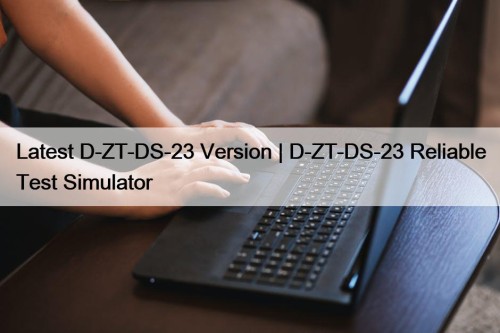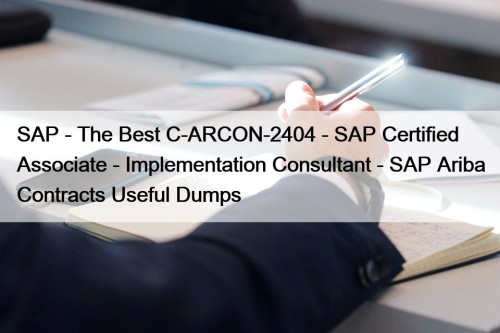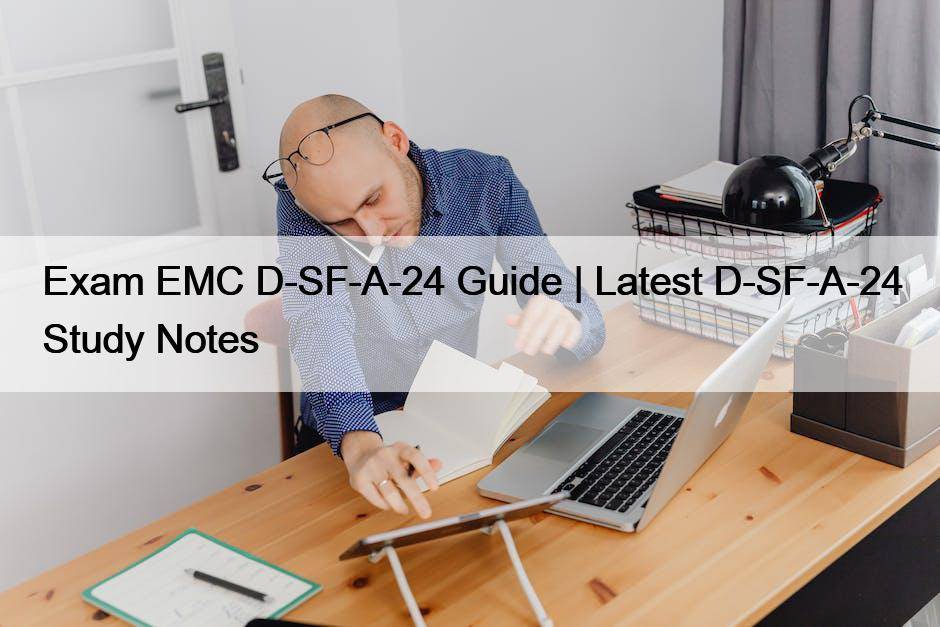Most Popular
 Latest D-ZT-DS-23 Version | D-ZT-DS-23 Reliable Test Simulator
Latest D-ZT-DS-23 Version | D-ZT-DS-23 Reliable Test Simulator
We have thousands of satisfied customers around the globe so ...
 C-ARP2P-2404 Latest Braindumps Questions | Exam C-ARP2P-2404 Online
C-ARP2P-2404 Latest Braindumps Questions | Exam C-ARP2P-2404 Online
2025 Latest PassReview C-ARP2P-2404 PDF Dumps and C-ARP2P-2404 Exam Engine ...
 SAP - The Best C-ARCON-2404 - SAP Certified Associate - Implementation Consultant - SAP Ariba Contracts Useful Dumps
SAP - The Best C-ARCON-2404 - SAP Certified Associate - Implementation Consultant - SAP Ariba Contracts Useful Dumps
DOWNLOAD the newest Free4Torrent C-ARCON-2404 PDF dumps from Cloud Storage ...



Exam EMC D-SF-A-24 Guide | Latest D-SF-A-24 Study Notes

What's more, part of that PDFVCE D-SF-A-24 dumps now are free: https://drive.google.com/open?id=1gz7ZocEPEr7DNR1P2AWjv992iG0d9ZsB
The software version is one of the different versions that is provided by our company, and the software version of the D-SF-A-24 study materials is designed by all experts and professors who employed by our company. We can promise that the superiority of the software version is very obvious for all people. It is very possible to help all customers pass the D-SF-A-24 Exam and get the related certification successfully.
EMC D-SF-A-24 Exam Syllabus Topics:
| Topic | Details |
|---|---|
| Topic 1 |
|
| Topic 2 |
|
| Topic 3 |
|
| Topic 4 |
|
| Topic 5 |
|
>> Exam EMC D-SF-A-24 Guide <<
100% Pass Reliable EMC - Exam D-SF-A-24 Guide
We are committed to designing a kind of scientific D-SF-A-24 study material to balance your business and study schedule. With our D-SF-A-24 exam guide, all your learning process includes 20-30 hours. As long as you spare one or two hours a day to study with our laTest D-SF-A-24 Quiz prep, we assure that you will have a good command of the relevant knowledge before taking the D-SF-A-24 exam. What you need to do is to follow the D-SF-A-24 exam guide system at the pace you prefer as well as keep learning step by step.
EMC Dell Security Foundations Achievement Sample Questions (Q19-Q24):
NEW QUESTION # 19
During the analysis, the threat intelligence team disclosed that attackers not only encrypted files, but also attempted to encrypt backups and shared, networked, and cloud drives.
Which type of ransomware is used for this attack?
- A. Crypto
- B. Locker
- C. Cryptolocker
- D. Double extortion
Answer: D
Explanation:
* Double Extortion Ransomware:This type of ransomware not only encrypts files but also attempts to encrypt backups and shared, networked, and cloud drives1.
* Attack Method:Attackers first exfiltrate sensitive data before encrypting it, then threaten to release the data if the ransom is not paid, hence the term 'double extortion'1.
* Impact on Organizations:This method increases the pressure on the victim to pay the ransom, as they face the risk of their sensitive data being published or sold1.
* Prevention and Response:Organizations should implement robust backup strategies, including offsite and offline backups, and have an incident response plan that includes dealing with ransomware and data breaches1.
Double extortion ransomware attacks are particularly dangerous because they combine the threat of data encryption with the threat of data exposure, significantly increasing the potential damage to the victim organization1.
NEW QUESTION # 20
The cybersecurity team performed a quantitative risk analysis onA .R.T.I.E.'s IT systems during the risk management process.
What is the focus of a quantitative risk analysis?
- A. Objective and mathematical models to provide risk acumens.
- B. Rank and handle risk to use time and resources more wisely.
- C. Evaluators discretion for resources.
- D. Knowledge and experience to determine risk likelihood.
Answer: A
Explanation:
Quantitative risk analysis in cybersecurity is a method that uses objective and mathematical models to assess and understand the potential impact of risks. It involves assigning numerical values to the likelihood of a threat occurring, the potential impact of the threat, and the cost of mitigating the risk. This approach allows for a more precise measurement of risk, which can then be used to make informed decisions about where to allocate resources and how to prioritize security measures.
The focus of a quantitative risk analysis is to provide risk acumens, which are insights into the level of risk associated with different threats. This is achieved by calculating the potential loss in terms of monetary value and the probability of occurrence. The result is a risk score that can be compared across different threats, enabling an organization to prioritize its responses and resource allocation.
For example, if a particular vulnerability in the IT system has a high likelihood of being exploited and the potential impact is significant, the quantitative risk analysis would assign a high-riskscore to this vulnerability.
This would signal to the organization that they need to address this issue promptly.
Quantitative risk analysis is particularly useful in scenarios where organizations need to justify security investments or when making decisions about risk management strategies. It provides a clear and objective way to communicate the potential impact of risks to stakeholders.
In the context of the Dell Security Foundations Achievement, understanding the principles of quantitative risk analysis is crucial for IT staff and application administrators.It aligns with the topics covered in the assessment, such as security hardening, identity and access management, and security in the cloud, which are all areas where risk analysis plays a key role123.
NEW QUESTION # 21
A .R.T.I.E.has an evolving need, which was amplified during the incidents. Their complex and dispersed IT environments have thousands of users, applications, and resources to manage. Dell found that the existing Identity and Access Management was limited in its ability to apply expanding IAM protection to applications beyond the core financial and human resource management application.A .R.T.I.E.also did not have many options for protecting their access especially in the cloud.A .R.T.I.E.were also not comfortable exposing their applications for remote access.
Dell recommended adopting robust IAM techniques like mapping out connections between privileged users and admin accounts, and the use multifactor authentication.
The Dell Services team suggest implementing a system that requires individuals to provide a PIN and biometric information to access their device.
Which type of multifactor authentication should be suggested?
- A. Something you have and something you know.
- B. Something you have and something you are.
- C. Something you know and something you are.
Answer: B
Explanation:
The recommended multifactor authentication (MFA) type forA .R.T.I.E., as suggested by Dell Services, isA.
Something you have and something you are. This type of MFA requires two distinct forms of identification:
one that the user possesses (something you have) and one that is inherent to the user (something you are).
* Something you havecould be a physical token, a security key, or a mobile device that generates time-based one-time passwords (TOTPs).
* Something you arerefers to biometric identifiers, such as fingerprints, facial recognition, or iris scans, which are unique to each individual.
By combining these two factors, the authentication process becomes significantly more secure than using any single factor alone. The physical token or device provides proof of possession, which is difficult for an attacker to replicate, especially without physical access. The biometric identifier ensures that even if the physical token is stolen, it cannot be used without the matching biometric input.
References:
* The use of MFA is supported by security best practices and standards, including those outlined by the National Institute of Standards and Technology (NIST).
* Dell's own security framework likely aligns with these standards, advocating for robust authentication mechanisms to protect against unauthorized access, especially in cloud environments where the attack surface is broader.
In the context ofA .R.T.I.E.'s case, where employees access sensitive applications and data remotely, implementing MFA with these two factors will help mitigate the risk of unauthorized access and potential data breaches. It is a proactive step towards enhancing the organization's security posture in line with Dell's strategic advice.
NEW QUESTION # 22
Based on the information in the case study, which security team should be the most suitable to perform root cause analysis of the attack and present the proposal to solve the challenges faced by theA
.R.T.I.E.organization?
- A. Ethical hackers
- B. Business advisory
- C. Threat intelligence
- D. Identity and Assess Management
Answer: C
Explanation:
* Role of Threat Intelligence:The threat intelligence team is specialized in investigating methodologies and technologies to detect, understand, and deflect advanced cybersecurity threats1.
* Root Cause Analysis:They have the expertise to analyze security events, uncover advanced threats, and provide insights into the root causes of cyberattacks1.
* Solution Proposal:Based on their analysis, the threat intelligence team can propose solutions to tackle the identified vulnerabilities and enhance the security posture ofA .R.T.I.E.1.
* Preventive Measures:Their knowledge of the latest developments in the security landscape allows them to recommend proactive measures to prevent future attacks1.
* Dell Security Foundations Achievement:The Dell Security Foundations Achievement documents emphasize the importance of threat intelligence in understanding and responding to cybersecurity incidents1.
The threat intelligence team's capabilities align with the requirements ofA .R.T.I.E.to address their cybersecurity challenges effectively1.
NEW QUESTION # 23
Dell Services team cannot eliminate all risks, but they can continually evaluate the resilience and preparedness ofA .R.T.I.E.by using the National Institute of Standards and Technology Cybersecurity Framework (NIST CSF).
Match the core NIST CSF component functions with the description that the Dell Services team would have recommended toA .R.T.I.E.
Answer:
Explanation:
Explanation:
Based on the Dell Security Foundations Achievement and the NIST Cybersecurity Framework (CSF), the core NIST CSF component functions can be matched with the descriptions as follows:
* Identify:Cultivate the organizational understanding of cybersecurity risks.
* Protect:Plan and implement appropriate safeguards.
* Detect:Develop ways to identify cybersecurity breaches.
* Respond:Quickly mitigate damage if a cybersecurity incident is detected.
* Recover:Restore capabilities that were impaired due to a cyberattack12345.
* Identify Function:Involves understanding the business context, the resources that support critical functions, and the related cybersecurity risks3.
* Protect Function:Includes the appropriate safeguards to ensure delivery of critical infrastructure services4.
* Detect Function:Defines the appropriate activities to identify the occurrence of a cybersecurity event4.
* Respond Function:Includes the appropriate activities to take action regarding a detected cybersecurity event4.
* Recover Function:Identifies appropriate activities to maintain plans for resilience and to restore any capabilities or services that were impaired due to a cybersecurity event4.
These functions are integral to the NIST CSF and provide a high-level strategic view of the lifecycle of an organization's management of cybersecurity risk12345.The Dell Security Foundations Achievement documents would likely align with these functions, emphasizing their importance in a comprehensive cybersecurity strategy12.
NEW QUESTION # 24
......
PDFVCE is a real dumps provider that ensure you pass the different kind of IT exam with offering you exam dumps and learning materials. You just need to use your spare time to practice the D-SF-A-24 Real Dumps and remember D-SF-A-24 test answers skillfully, you will clear EMC practice exam at your first attempt.
Latest D-SF-A-24 Study Notes: https://www.pdfvce.com/EMC/D-SF-A-24-exam-pdf-dumps.html
- Free PDF EMC - D-SF-A-24 - Newest Exam Dell Security Foundations Achievement Guide 🤏 Search for ( D-SF-A-24 ) and download it for free immediately on ➡ www.prep4pass.com ️⬅️ 🥛D-SF-A-24 Passleader Review
- D-SF-A-24 Pass4sure Pass Guide 🕴 Test D-SF-A-24 Assessment ⛹ D-SF-A-24 Pass4sure Pass Guide 🙁 Easily obtain ➽ D-SF-A-24 🢪 for free download through ☀ www.pdfvce.com ️☀️ 🚞D-SF-A-24 Exam Sample Online
- One of the Best Ways to Prepare For the D-SF-A-24 💃 Search for 【 D-SF-A-24 】 and download it for free on { www.pdfdumps.com } website 🍵D-SF-A-24 Latest Test Labs
- D-SF-A-24 Exam Dumps Get Success With Minimal Effort 🌷 Go to website ⏩ www.pdfvce.com ⏪ open and search for ➠ D-SF-A-24 🠰 to download for free 🤤D-SF-A-24 Latest Test Labs
- Reliable D-SF-A-24 Test Syllabus 🚤 D-SF-A-24 Latest Test Labs ⚗ Valid D-SF-A-24 Cram Materials 🔥 Immediately open 【 www.testkingpdf.com 】 and search for ➥ D-SF-A-24 🡄 to obtain a free download 🌁Exam D-SF-A-24 Consultant
- Trustworthy D-SF-A-24 Source 📔 Reliable D-SF-A-24 Test Syllabus 🔼 Reliable D-SF-A-24 Test Syllabus 😊 Easily obtain free download of ☀ D-SF-A-24 ️☀️ by searching on ➥ www.pdfvce.com 🡄 🧳Valid D-SF-A-24 Test Voucher
- Exam D-SF-A-24 Consultant 🌱 D-SF-A-24 Latest Test Labs 📧 Exam D-SF-A-24 Consultant 🦃 Search for ➤ D-SF-A-24 ⮘ and download it for free on { www.testsimulate.com } website 🍂D-SF-A-24 Exam Sample Online
- Latest D-SF-A-24 Exam Guide 👏 Valid D-SF-A-24 Cram Materials 🌏 D-SF-A-24 Passleader Review 💎 Search for 《 D-SF-A-24 》 and download it for free on 「 www.pdfvce.com 」 website 🐗Valid D-SF-A-24 Exam Simulator
- D-SF-A-24 Exam Dumps Get Success With Minimal Effort 👵 Open ⏩ www.pass4leader.com ⏪ enter ⇛ D-SF-A-24 ⇚ and obtain a free download 😞Valid D-SF-A-24 Exam Simulator
- D-SF-A-24 Study Materials - D-SF-A-24 Exam Preparatory - D-SF-A-24 Test Prep 🔯 Search for ➤ D-SF-A-24 ⮘ and obtain a free download on ➽ www.pdfvce.com 🢪 🅿D-SF-A-24 Exams Torrent
- D-SF-A-24 Study Materials - D-SF-A-24 Exam Preparatory - D-SF-A-24 Test Prep 🧄 Search for ▷ D-SF-A-24 ◁ and download it for free immediately on ⇛ www.exam4pdf.com ⇚ 🌊Reliable D-SF-A-24 Dumps Sheet
- D-SF-A-24 Exam Questions
- www.so0912.com paidai123.com shufaii.com kazmhameedforads.com learningskill.site lms.slikunedu.in crazy.pokuyo.com teteclass.com sics.pk zero2oneuniversity.in
BTW, DOWNLOAD part of PDFVCE D-SF-A-24 dumps from Cloud Storage: https://drive.google.com/open?id=1gz7ZocEPEr7DNR1P2AWjv992iG0d9ZsB
Tags: Exam D-SF-A-24 Guide, Latest D-SF-A-24 Study Notes, Latest D-SF-A-24 Braindumps Files, D-SF-A-24 Valid Braindumps Pdf, Certification D-SF-A-24 Questions